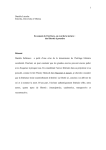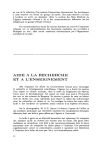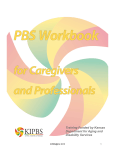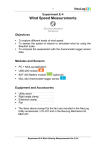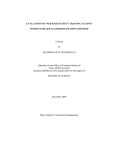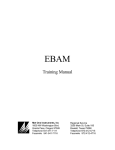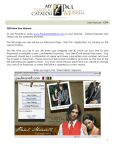Download Students will understand and apply measurement tools and
Transcript
Grade: 5th grade Standard IV: Students will understand and apply measurement tools and techniques. Objective 1: Identify and describe measurable attributes of objects and units of measurement. Intended Learning Outcomes: 1. 2. 3. 4. 5. 6. Demonstrate a positive learning attitude toward mathematics. Become mathematical problem solvers. Reason mathematically. Communicate mathematically. Make mathematical connections. Represent mathematical situations Content Connections: Language Arts Standards II & VIII, and Social Studies Standards 4 & 8. Activity Title: Measuring Me Background Information: This activity is a good cross-curricular investigation of Objectives1 & 2 of Standard IV of the 5th grade Core Curriculum. It relies on two pieces of literature: Millions to Measure by David M. Schwartz and Measuring Penny by Loreen Leedy. The students will learn the importance of accurate measurement both in customary and metric units. They will gain an understanding of the relationship between units of measurement in the metric system. Students will be able to compare and contrast customary measure and metric. Research Base: Students should be encouraged to defend, question, and clarify their mathematical ideas. Discussion is one of the most important components to students gaining mathematical understanding. If they can express themselves orally, then journaling becomes easier. Teachers should listen carefully to the students’ ideas. The teacher’s role is to facilitate discussion; providing information, clarification, and modeling if needed. The students are to investigate, form conjectures, and determine mathematical evidence to be used in their discussions and journaling. Van Zoest, Laure & Enyart, Ann. (1998, November-December). Discourse, of Course: Encouraging Genuine Mathematical Conversations, Mathematics Teaching in the Middle Schools, 4(3), 151-157. In learning measurement, students should be actively involved, drawing on familiar and accessible contexts, i.e.: body parts. The first step is to understand measurable attributes of objects and the units of measurement – both customary and metric. Measurement is the bridge from number sense to geometry. Connection(s) must be made to real world applications. Students should investigate a wide variety of applications. Principles and Standards for School Mathematics. (2000). Reston, VA: The National Council of Teachers of Mathematics Materials: Schwartz, David M. (2003). Measuring a Million. Harper Collins Publishers Leedy, Loreen. (1997). Measuring Penny. Henry Holt & Co. Measuring cups and spoons: customary and metric Ruler with customary and metric measures Scale(s): customary and metric Tape Measure Paper Pencils Worksheet(s) Assessment: Informal Observations: Observe students while they are working in groups and individually. Did they work well in cooperative groups? Were the materials used properly and accurately? Could the students present and discuss their opinions and feelings. Formal: (options) 1. Turn in completed worksheet, “Measuring Me.” 2. In cooperative groups, students will find the measurements to create the average student representing their group. This will also reinforce the concept of mean. 3. Did the student adequately journal this activity with procedure, observations and conclusion described and illustrated? Invitation to Learn: Have each student measure his/her foot and report their measurement on board. Read Millions to Measure. Journal the following question: Should the U.S. join the rest of the world and measure only in the metric system? Discuss the journal responses. Instructional Procedures: 1. 2. 3. 4. 5. 6. 7. Read Measuring Penny. Discuss how this story compares with Millions to Measure. In cooperative groups, each student will measure (in both units of measure) and record their body parts listed on their worksheet, “Measuring Me.” In cooperative groups, the students should take their measurements (to the nearest ½ inch or inch) and average each body part to obtain the average measurement representing the students in their groups. Remind the class that the mean is an average and it is obtained by adding the set of data for the same body part and dividing by the numbers of units in that set. The class will then create a chart or graph representing the comparison of all the groups in the classroom. Using the “Measuring Me 2” worksheet, the students will follow the directions and complete the assignment. (This may take a few days.) The teacher should stress accurate measuring and creativity. Students can choose to present their work in a variety of formats. Discuss/brainstorm the different formats that could be used for “publishing” this assignment. Discuss the Extension activities. Optional: Model with class an example. Use brainstorming and consensus to chose activity. Curriculum Extensions: • • • Students will create their own unit of measure using a body part. They will need to explain their reasoning and give three examples of its use. Each student could create a book (see “Millions to Measure” activity, step 4), in the same pattern as Measuring Penny, entitled “Measuring Me.” Students could create their own menu for a simple dinner and measure appropriate portions using the measuring cups and spoons, and a scale. Teacher may want to provide guidelines on size of portions or the size of the entire meal. Resources: Schwartz, David M. (2003). Millions to Measure. Harper Collins Publishers. ISBN 0-688-12916-1 (only available in hard-bound) Leedy, Loreen. (1997). Measuring Penny. Henry Hold & Co. ISBN 0-8050-6572-5 Krpan, Cathy Marks. (2001). The Write Math: Writing in the Math Classroom. Dale Seymore Publications. ISBN 0-7690-2505-6 Anderson, Catherine (Ed.). (1998). Investigations in Number, Data, and Space: Measurement Benchmarks – Estimating and Measuring. White Plains, NY. Dale Seymore Publications. ISBN 1-57232-801-0 Your Body Ruler – A User’s Manual. 29 February 2005. http://vendian.org/mncharity/dir3body ruler Rowlett, Russ. The Metric System in the United States. University of North Carolina at Chapel Hill. http://www.unc.edu/~rowlett/units/usmetric.html Family Connections: • Students and their families can use Measuring Penny as a model for measuring one of their pets and comparing to other animals found around the home and/or neighborhoods. Use the worksheet “Measuring Me 2” as an outline for this home activity. Name: ______________________________ Measuring Me You will measure different parts of your body using customary and metric units of measure. Choose an appropriate unit of measure. Record your measurements on this page. (When using customary, you may round your measurement to the nearest half inch or inch.) My Measurements Customary Metric Head (circumference) Across Shoulders Arm (shoulder to wrist) Hand (wrist to end of longest finger) Waist Inseam Foot Me My Group (Customary) 2 3 4 Mean Me My Group (Metric) 2 3 4 Mean Head Shoulder Arm Hand Waist Inseam Foot Head Shoulder Arm Hand Waist Inseam Foot Use this space (and back) to reflect upon your investigation. Explain how these measurements could be used in a real world situation. Name: ___________________________ Measuring Me 2 Using Mr. Jayson’s model from the book Measuring Penny, do the assignment as outlined below. 1. Choose something to measure. 2. Measure it in as many ways as you can: height, width, length, weight, volume, temperature, time, etc. 3. Record your results. 4. Include at least one comparison: EX. “It is taller than…” or “heavier than…” etc. Remember, a measurement always has two parts: 1. 2. EX. A number A unit “I am 6 feet tall.” Which units can you use? Examples: Standard Units: inches, feet, yards, centimeters, meters, teaspoons, cups, gallons, pounds, minutes, etc. Non-standard Units: paper clips, bricks, frogs, marbles, pencils, toes, etc. Be Creative!





